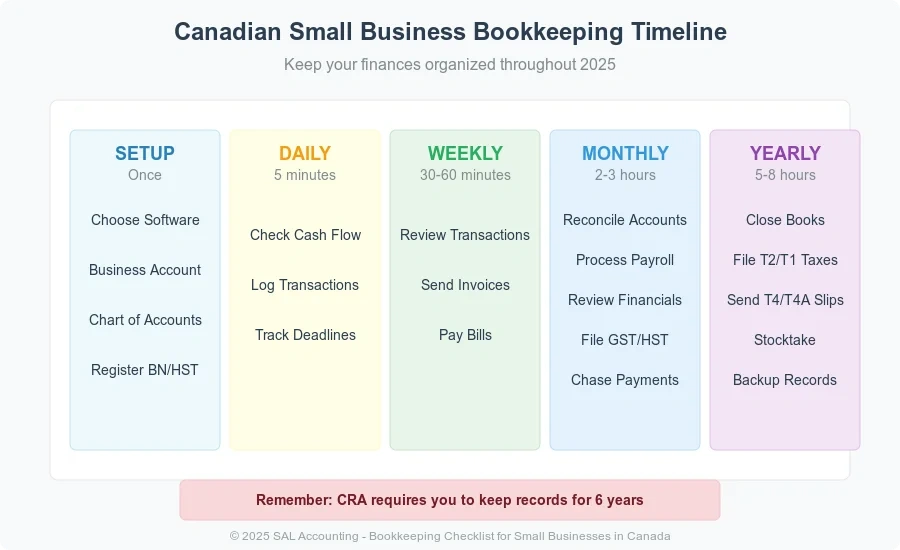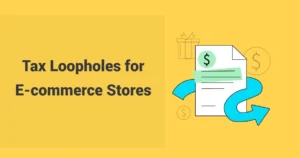Running a small business in Canada is exciting, but sorting out your finances can feel tricky. A bookkeeping checklist for small businesses in Canada helps you stay organized and calm. About 60% of owners say accounting trips them up, leading to errors. With 2025 changes like Nova Scotia’s HST falling to 14%, a clear small business bookkeeping checklist is a must.
This guide is perfect for Canadian entrepreneurs, freelancers, and startups—especially folks needing a small business accounting checklist in Canada. It offers simple steps to ensure CRA compliance, manage Canadian business taxes, and keep your books audit-ready. Stay with SAL Accounting and let’s dive in!
Quick Takeaways
- A small business bookkeeping checklist organizes your finances for CRA compliance and growth.
- Covers setup, daily, weekly, monthly, quarterly, and yearly tasks tailored for Canada.
- Saves time with bookkeeping software for small businesses in Canada, like QuickBooks or Wave.
- Reduces tax stress by tracking deductions and filing GST/HST correctly.
Why Your Canadian Small Business Needs a Bookkeeping Checklist
Bookkeeping is your business’s roadmap—it shows where your money’s at and where it’s going. Without it, cash flow problems sink 21.5% of Canadian small businesses in their first year, according to Made in CA. A solid small business accounting checklist in Toronto or anywhere in Canada prevents these issues. A bookkeeping checklist for small businesses in Canada lays out setup, daily, weekly, monthly, quarterly, and yearly tasks. It covers CRA compliance, GST/HST filing, payroll bookkeeping checklists, and Canadian business taxes, ensuring you’re ready for audits and stress-free.
Here’s what it does:
- Ensures CRA compliance, avoiding audits that hit 54% of small businesses with $17,000 penalties.
- Tracks cash flow, a worry for 33% of owners short on funds.
- Find tax savings, like deductions for your home office or car.
- Spots trends to grow your business smarter.
Whether you’re a freelancer needing a small business accounting checklist or a national startup, this checklist keeps your money on track. Now, let’s explore the setup basics to get your bookkeeping started right.
Build Your Small Business Bookkeeping: Setup Basics
A good setup saves you time and hassle. Creating a CRA-friendly system takes a few hours but makes everything easier.
Every Canadian business needs tools to stay on top of their books. Pick bookkeeping software for small business Canada to handle GST/HST filing, payroll, and more, ensuring CRA compliance:
- QuickBooks Canada: Robust for taxes, payroll, and reports, integrates with CRA forms ($20/month).
- Wave: Free for basic invoicing and tracking, ideal for startups, with payroll add-on ($20/month).
- Xero: Cloud-based, great for freelancers and e-commerce ($13/month).
- Wagepoint: Automates payroll bookkeeping checklists and T4s ($20/month).
- Dext: Digitizes receipts, meeting CRA’s six-year rule ($10/month).
Software automates 75% of tasks, saving 15 hours monthly. For tight budgets, spreadsheets work, but automation is a game-changer. Our CPA accountants in Toronto can recommend the best setup for your business.
Pro Tip: Choose tools like Xero or QuickBooks that sync with CRA’s My Business Account for seamless tax filing.
Read more: “Best Bookkeeping Tools for Small Business Owners in Canada”
2. Set Up Your Financial Structure
Open a business bank account to separate personal and business funds. Mixing them can trigger CRA audits. Create a chart of accounts to organize income (like sales), expenses (like rent), assets (like ovens), and liabilities (like loans). This matches CRA forms like T2125 for freelancers.
Pro Tip: Find free chart templates online to fit CRA rules.
3. Register for CRA Requirements
If your taxable sales top $30,000 yearly, register for a Business Number (BN) for GST/HST filing, payroll, or taxes. Then, choose your GST/HST filing frequency based on revenue:
- Monthly: For businesses with over $6M in revenue.
- Quarterly: For $1.5M–$6M in revenue.
- Yearly: For under $1.5M in revenue.
This ensures compliance with Canadian business taxes and payroll bookkeeping checklists if you have staff.
Pro Tip: Under $30,000? You can skip GST/HST but might register to claim tax credits.
Here’s a setup checklist to guide your initial steps:
| ✓ Task | ⏱ Frequency | 📎 Tools Used |
| Choose software | Once | QuickBooks, Wave, Xero |
| Set up chart of accounts | Once | Software templates |
| Open business bank account | Once | RBC, BMO, TD |
| Register for BN | Once | CRA My Business Account |
| Determine GST/HST filing | Once | CRA guidelines |
| Set up payroll | Once | Wagepoint, ADP Canada |
Read more: “GST/HST Return in Canada: A Guide for Businesses & Cross-Border Taxation”
Now, let’s dive into the daily bookkeeping tasks to keep your finances on track.
Daily Bookkeeping: Stay on Top
Daily tasks are quick but keep your books clean. Spend 5 minutes to stay organized.
1. Check Cash Flow
Look at bank balances and petty cash to cover costs like supplier bills.
2. Log Transactions
Enter sales, expenses, or payments into your software, using bank feeds for speed.
3. Track Deadlines
Watch CRA deadlines for GST/HST filing or payroll bookkeeping checklists to avoid fines.
Pro Tip: Use your software’s app to log things fast, saving time later.
Let’s move on to weekly tasks to keep your books tidy and organized.
Weekly Bookkeeping: Keep Things Neat
Weekly tasks tidy your records. Set aside 30-60 minutes to stay sharp.
1. Review Transactions
Check bank feeds and sort transactions into CRA categories (like sales or fuel). This catches mistakes early.
2. Handle Invoices and Bills
Stay on top of cash flow with these steps:
- Send Invoices: Use Net 30 terms, numbering them in order to track payments.
- Pay Suppliers: Settle bills fast, grabbing discounts when you can.
Pro Tip: Scan and keep records with Dext to store them digitally, meeting CRA’s six-year rule.
3. Sort Files
Save invoices and receipts digitally or in supplier folders, splitting paid from unpaid.
Now, let’s tackle monthly tasks to ensure your books are accurate and CRA-ready.
Monthly Bookkeeping: Lock in Accuracy
Monthly tasks ensure your books are right and CRA-ready. Plan for 2-3 hours, less if you nail weekly tasks (8-10 hours for small shops, per research). Break big jobs like reconciliations into small steps for easier work.
1. Reconcile Accounts
Match bank, credit card, and merchant accounts (like Square for shops) to your records. Automation in tools like QuickBooks cuts time here. This spots errors like double charges.
2. Manage Payroll
For staff, follow these steps to stay compliant:
- Calculate Wages: Determine employee pay accurately.
- Process CRA Deductions: Include CPP (5.95%) and EI (1.63% in 2023).
- Submit Remittances: Send payments to CRA on time.
- Secure Records: Keep data safe to follow PIPEDA privacy rules.
Pro Tip: Wagepoint simplifies payroll bookkeeping checklists with auto-T4s.
3. Check Financials
Review profit and loss (P&L), balance sheet, and cash flow reports. Compared to last year for trends, like growing sales or rising costs.
4. File GST/HST (If Monthly)
Send returns one month after the period, claiming input tax credits to cut taxes via CRA’s My Business Account.
5. Chase Payments
Keep cash flowing with these actions:
- Check Ageing Report: Track overdue invoices.
- Send Reminders: Use kind notes for new debts, firmer for older ones.
- Offer Payment Plans: Help clients pay if they’re struggling.
Here’s a monthly checklist to guide your tasks:
| ✓ Task | ⏱ Frequency | 📎 Tools Used |
| Reconcile accounts | Monthly | QuickBooks, Wave, Xero |
| Process payroll | Monthly | Wagepoint, ADP Canada |
| Review financial statements | Monthly | Software templates |
| File GST/HST (if monthly) | Monthly | CRA My Business Account |
| Review receivables | Monthly | Ageing reports, CRM tools |
Case Study: E-commerce Owner Fixes GST/HST Mess
Problem: Sophia runs an online boutique in Calgary, making $450,000 yearly across Shopify, Amazon, and Etsy. She wasted 15 hours monthly on spreadsheets and missed $8,700 in tax credits last year. “I had no clue if I was doing GST right or leaving money behind,” she told us.
What We Did: We set up A2X to pull in her platform sales automatically and connected QuickBooks with proper GST/HST tracking. We built a CRA-friendly chart of accounts and fixed her reconciliations. We got back those missed credits through a CRA adjustment and created a simple monthly review.
Result: Sophia now spends just 2 hours on books instead of 15. She got back $8,700 and now claims an extra $1,200 quarterly in GST/HST refunds. “My CRA review went smooth as butter,” she says. “And I found time to launch a new product line bringing in $5,000 monthly.”
Next, let’s explore quarterly tasks to keep your taxes in check.
Quarterly Bookkeeping: Stay Tax-Smart
Quarterly tasks keep Canadian business taxes in check and adjust your plans. Spend an hour here.
1. File GST/HST (If Quarterly)
Send returns one month after the period, checking credits carefully.
2. Review Provincial Taxes
Look at taxes like BC PST or city fees on provincial sites.
3. Update Budgets
Tweak for performance or seasonal changes, key for shops or services.
Pro Tip: Save cash for GST/HST installments if you file yearly with net tax over $3,000.
Now, let’s wrap up with yearly tasks to close your books and plan ahead.
Yearly Bookkeeping: Wrap Up Your Year
Your year-end bookkeeping checklist Canada wraps taxes and sets 2025 goals. Start in December, planning 5-8 hours. Break tasks like tax prep into smaller steps for less stress. Stay ready for 2025 updates, like Nova Scotia’s HST drop or 66.67% capital gains rate.
1. Close Records
Finish books, adjusting for depreciation with CRA’s Capital Cost Allowance (CCA). Lock with a password to keep data safe.
2. File Taxes
Submit T2 (corporations, six months after year-end) or T1 with T2125 (freelancers, June 15). List foreign income on T1135 if assets top CAD $100,000, noting 2025’s capital gains rate.
Pro Tip: Save for Canadian business taxes early to stay calm. Our small business tax accountants in Toronto can ensure you maximize deductions while staying compliant.
3. Send Tax Slips
Share T4 (staff) and T4A (contractors) by February 28, checking perks like company cars.
4. Plan and Protect
Handle these final steps:
- Do a Stocktake: Get the cost of goods sold right for inventory.
- Chase Overdue Payments: Use gentle or firm reminders, maybe offering payment plans.
- Update Vendor Details: Keep supplier info current.
- Review Marketing Results: Assess what worked.
- Budget for Seasonal Dips: Plan ahead.
- Back Up Records: Use two cloud and one offline copy, plus paper copies, per CRA’s six-year rule.
Pro Tip: E-commerce? Use A2X to simplify bookkeeping. Talk to our e-commerce bookkeepers for more info.
Example: Alex’s year-end stocktake found $800 in old pastries he wrote off for taxes. He claimed $7,000 in deductions, setting his bakery up for a great 2025.
Here’s a year-end checklist to guide your tasks:
| ✓ Task | ⏱ Frequency | 📎 Tools Used |
| Close books | Yearly | QuickBooks, Xero |
| File taxes | Yearly | T2, T1, T2125 forms |
| Issue T4/T4A slips | Yearly | Wagepoint, ADP Canada |
| Stocktake | Yearly | Inventory software |
| Review receivables | Yearly | Ageing reports, CRM tools |
| Update vendors | Yearly | Accounts payable software |
| Backup records | Yearly | Cloud storage, external drives |
| Plan budgets | Yearly | Budget templates |
Read more: “Corporate Tax Deadlines in 2025: A Complete Guide for Canadian Businesses”
Your Bookkeeping Checklist for Small Business in Canada
Here is the best bookkeeping checklist you can have to keep your business finances on track:
✓ Choose bookkeeping software
✓ Set up a business bank account
✓ Create a chart of accounts
✓ Register for a Business Number (BN) if sales exceed $30,000
✓ Check cash flow daily
✓ Log transactions daily
✓ Track CRA deadlines daily
✓ Review transactions weekly
✓ Manage invoices weekly
✓ Reconcile accounts monthly
✓ File GST/HST returns (monthly or quarterly)
✓ Close books yearly
✓ File taxes yearly

Common Bookkeeping Mistakes to Avoid
Mistakes can mess up your books and stress you out. Here are pitfalls to watch for:
- Skipping Reconciliations: Not matching bank and software records misses errors, risking audit issues. Reconcile monthly to stay clean.
- Mixing Personal and Business Funds: Using one account for both confuses taxes and flags CRA audits. Open a separate business account.
- Missing Deadlines: Late GST/HST filing or T4 submissions trigger fines. Track deadlines daily to stay safe.
- Ignoring Small Expenses: Forgetting receipts for coffee or gas loses deductions. Log every expense, even tiny ones.
- Not Backing Up: Losing digital records hurts during audits. Save paper and cloud backups for six years.
Case Study: Contractor Dodges Audit Trouble
Problem: Marcus, a Toronto contractor earning $375,000 yearly, got a CRA letter asking for three years of expense records. “I kept receipts in shoeboxes and used Excel when I remembered,” he admitted. He claimed $42,000 in vehicle expenses but couldn’t prove almost half of them.
What We Did: We got Dext for digital receipts and sorted his paperwork mess. We rebuilt his mileage logs using his calendar and invoice locations and fixed his home office documentation. We set up QuickBooks with proper CRA categories and taught him a simple weekly routine.
Result: Marcus passed the CRA review with no penalties (saving a potential $17,500 hit). He now spends 10 minutes daily on bookkeeping using his phone. “This system paid for itself right away,” he says. “I also found another $13,200 in deductions I’d been missing. My accountant was shocked at how organized everything was, and my tax season stress dropped from 9 to 2.”
Read more: “6 E-Commerce Accounting Errors That Could Cost You Thousands”
Conclusion
This bookkeeping checklist for small businesses in Canada keeps your finances on track for 2025. It guides you through setup with bookkeeping software for small business Canada, daily logs, weekly invoices, monthly reconciliations, quarterly GST/HST filing, and year-end bookkeeping checklist Canada tasks. You’ll ensure CRA compliance and reduce tax stress. Whether you’re a Toronto freelancer using a small business accounting checklist Toronto or a national startup, this small business bookkeeping checklist simplifies Canadian business taxes, streamlines payroll bookkeeping checklists, and helps you spot growth opportunities.
For a hassle-free experience, reach SAL Accounting bookkeepers in Toronto—our experts handle GST/HST filing, payroll, and e-commerce bookkeeping like pros. Book your free consultation now!
FAQs: Your Bookkeeping Questions Answered
A small business bookkeeping checklist includes setup (software, BN), daily logs, weekly invoices, monthly checks, quarterly GST/HST filing, and yearly taxes, all keeping you CRA-ready.
CRA says store records like invoices and payroll for six years.
DIY with Wave or CRA tips works for basics. For tricky payroll bookkeeping checklists or audits, pros save time and stress.
Bookkeeping software for small business Canada like QuickBooks, Wave, Xero, and A2X for e-commerce fits CRA needs perfectly.
Monthly tasks include reconciling accounts, managing payroll, reviewing financials, filing GST/HST (if monthly), and chasing overdue payments, ensuring CRA compliance and accurate books.
For year-end bookkeeping checklist Canada, close books, file taxes (T2 or T1/T2125), issue T4/T4A slips, and plan budgets, starting in December to meet CRA deadlines stress-free.






